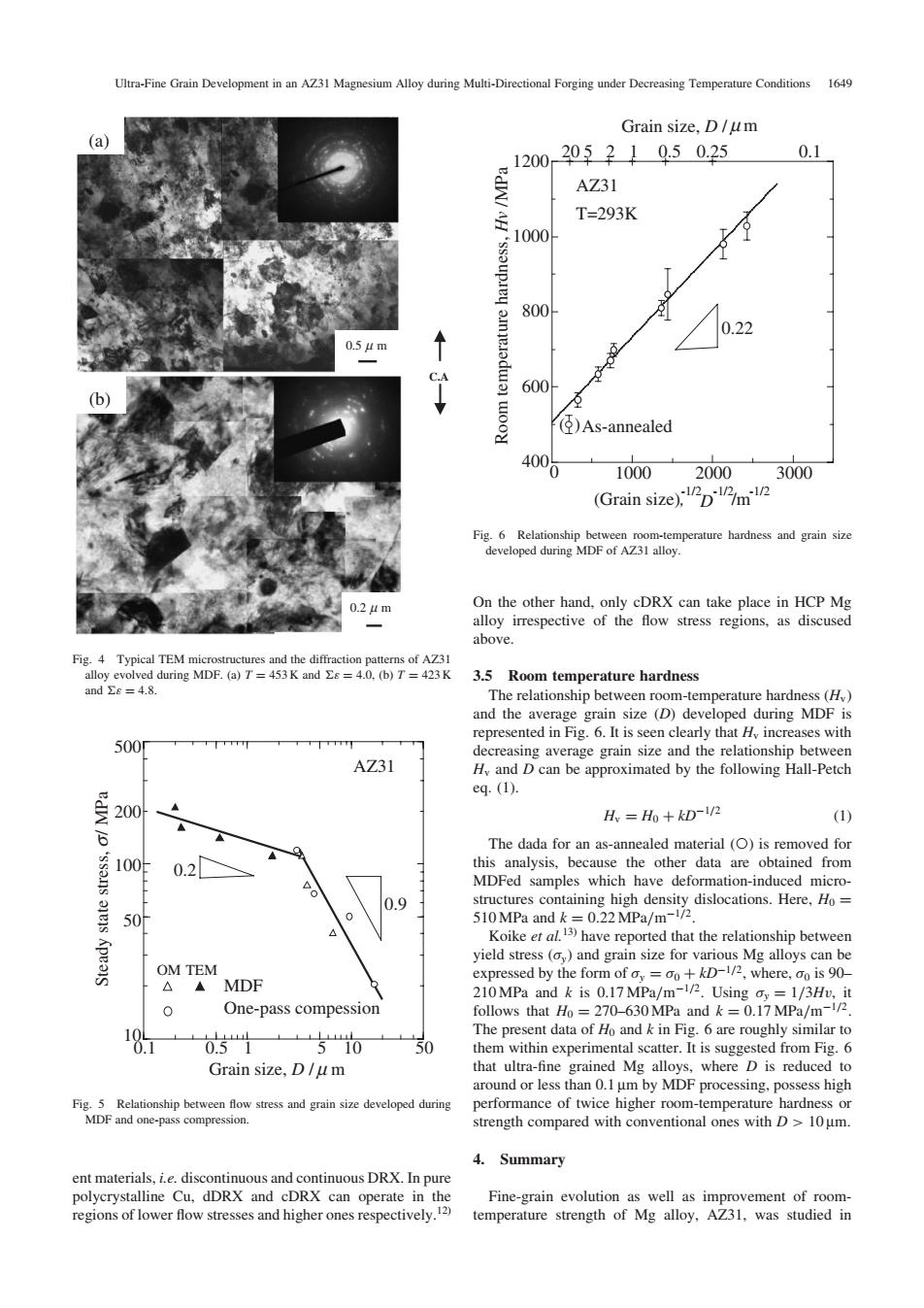正在加载图片...

Ultra-Fine Grain Development in an AZ31 Magnesium Alloy during Multi-Directional Forging under Decreasing Temperature Conditions 1649 Grain size,D/um (a) 1200 205210.5025 0.1 AZ31 T=293K 1000 800 0.22 0.5μm 600 (b) (径)As-annealed 400 0 1000 20003000 (Grain size)Dm Fig.6 Relationship between room-temperature hardness and grain size developed during MDF of AZ31 alloy. 0.24m On the other hand,only cDRX can take place in HCP Mg alloy irrespective of the flow stress regions,as discused above Fig.4 Typical TEM microstructures and the diffraction patterns of AZ31 alloy evolved during MDF.(a)T=453K and Es=4.0.(b)T 423K 3.5 Room temperature hardness and Es=4.8. The relationship between room-temperature hardness(H) and the average grain size (D)developed during MDF is represented in Fig.6.It is seen clearly that H increases with 500r TTTT decreasing average grain size and the relationship between AZ31 H and D can be approximated by the following Hall-Petch eq.(1). ▲ H,=H+kD-12 (1) 6 The dada for an as-annealed material (O)is removed for 100F 0.2 this analysis,because the other data are obtained from MDFed samples which have deformation-induced micro- 0.9 structures containing high density dislocations.Here,Ho 50 510 MPa and k =0.22 MPa/m-1/2. Koike et al.3)have reported that the relationship between yield stress(o)and grain size for various Mg alloys can be OM TEM △▲ MDF expressed by the form of ay=o+kD-1/2,where,oo is 90- 210 MPa and k is 0.17 MPa/m-12.Using oy =1/3Hv,it 0 One-pass compession follows that Ho=270-630 MPa and k=0.17 MPa/m-1/2 1 The present data of Ho and k in Fig.6 are roughly similar to 0.1 0.51 510 50 them within experimental scatter.It is suggested from Fig.6 Grain size,D/um that ultra-fine grained Mg alloys,where D is reduced to around or less than 0.1 um by MDF processing,possess high Fig.5 Relationship between flow stress and grain size developed during performance of twice higher room-temperature hardness or MDF and one-pass compression. strength compared with conventional ones with D>10 um. 4.Summary ent materials,i.e.discontinuous and continuous DRX.In pure polycrystalline Cu,dDRX and cDRX can operate in the Fine-grain evolution as well as improvement of room- regions of lower flow stresses and higher ones respectively.12) temperature strength of Mg alloy,AZ31,was studied inent materials, i.e. discontinuous and continuous DRX. In pure polycrystalline Cu, dDRX and cDRX can operate in the regions of lower flow stresses and higher ones respectively.12) On the other hand, only cDRX can take place in HCP Mg alloy irrespective of the flow stress regions, as discused above. 3.5 Room temperature hardness The relationship between room-temperature hardness (Hv) and the average grain size (D) developed during MDF is represented in Fig. 6. It is seen clearly that Hv increases with decreasing average grain size and the relationship between Hv and D can be approximated by the following Hall-Petch eq. (1). Hv ¼ H0 þ kD1=2 ð1Þ The dada for an as-annealed material ( ) is removed for this analysis, because the other data are obtained from MDFed samples which have deformation-induced microstructures containing high density dislocations. Here, H0 ¼ 510 MPa and k ¼ 0:22 MPa/m1=2. Koike et al.13) have reported that the relationship between yield stress (y) and grain size for various Mg alloys can be expressed by the form of y ¼ 0 þ kD1=2, where, 0 is 90– 210 MPa and k is 0.17 MPa/m1=2. Using y ¼ 1=3Hv, it follows that H0 ¼ 270{630 MPa and k ¼ 0:17 MPa/m1=2. The present data of H0 and k in Fig. 6 are roughly similar to them within experimental scatter. It is suggested from Fig. 6 that ultra-fine grained Mg alloys, where D is reduced to around or less than 0.1 mm by MDF processing, possess high performance of twice higher room-temperature hardness or strength compared with conventional ones with D > 10 mm. 4. Summary Fine-grain evolution as well as improvement of roomtemperature strength of Mg alloy, AZ31, was studied in C.A (a) 0.5 µ m (b) 0.2 µ m Fig. 4 Typical TEM microstructures and the diffraction patterns of AZ31 alloy evolved during MDF. (a) T ¼ 453 K and " ¼ 4:0, (b) T ¼ 423 K and " ¼ 4:8. Steady state stress, Grain size, D / 10 50 100 200 500 0.1 0.5 1 5 10 50 AZ31 MDF One-pass compession 0.9 0.2 OM TEM σ/ MPa µ m Fig. 5 Relationship between flow stress and grain size developed during MDF and one-pass compression. 1000 2000 3000 400 600 800 1000 1200 Room temperature hardness, Hv /MPa (Grain size), -1/2 -1/2/m-1/2 AZ31 T=293K 20 5 0.25 0.1 1 Grain size, D / 0.5 0 2 ( )As-annealed 0.22 D µ m Fig. 6 Relationship between room-temperature hardness and grain size developed during MDF of AZ31 alloy. Ultra-Fine Grain Development in an AZ31 Magnesium Alloy during Multi-Directional Forging under Decreasing Temperature Conditions 1649�������